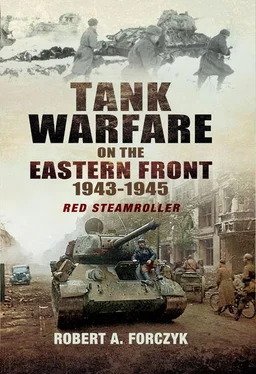In order to achieve decisive success in war, particularly mobile warfare, one must be willing to take risks, but it takes a combination of experience – and luck – to know when the risks become unacceptably dangerous. German panzer commanders had figured this dynamic out in 1941–42 and often managed to made it work for them; in the post-Stalingrad hubris Vatutin believed that he could accomplish this feat as well, although the tools and subordinates available were not up to the task.
Gruppe Hollidt’s main position was near the airfield at Morozovskaya, on the main rail line to Stalingrad, which was held by the remnants of the 22.Panzer-Division and the 7. and 8.Luftwaffe Feld-Divisionen. Vatutin attempted a pincer operation against this strongpoint, attacking from the north with Badanov’s ad hoc armoured group and from the east with General-major Mikhail D. Borisov’s 8th Cavalry Corps and some of Popov’s armour. Considering the poor quality of the defence, Popov’s 5th Tank Army should have simply rolled over the two inexperienced Luftwaffe divisions, but instead it merely pushed them back and the 22.Panzer-Division abandoned Morozovskaya on 4 January. South of Morozovskaya, Eremenko had sent the 1st Guards Rifle Corps from 2 GA across the Don to push in Hollidt’s right flank near Tsimlyansk and Hollidt was obliged to commit Balck’s 11.Panzer-Division to prevent this flank from collapsing. Meanwhile, Lelyushenko’s 3rd Guards Army was gradually overcoming the XXXXVIII Panzerkorps and the commitment of General-major Efim G. Pushkin’s refitted 23rd Tank Corps from front reserve threatened to break Hollidt’s left wing, so von Manstein decided to send the fresh 7.Panzer-Division to reinforce von Knobelsdorff’s sector.
Generalleutnant Hans Freiherr von Funck’s 7.Panzer-Division began detraining near Kamensk on 5 January and brought 91 Pz III Ausf L/M, 14 Pz III Ausf N and 18 Pz IV Ausf G, as well as a company of Marder III Panzerjäger. In addition to the welcome addition of the full-strength Panzer-Regiment 25 with two battalions, von Funck’s 7.Panzer-Division brought four fresh Panzergrenadier-Bataillonen into the fight, including one equipped with SPWs. Less than 48 hours after detraining, the lead Kampfgruppe from 7.Panzer-Division marched eastward to confront Pushkin’s 23rd Tank Corps, which was shoving its way past the depleted 6.Panzer-Division’s left flank. Like the proverbial cavalry arriving in the nick of time, von Funck’s veteran panzers halted the Soviet armoured advance in a series of tank battles fought on the steppes amid swirling snow showers. Lelyushenko’s 3rd Guards Army was brought to a screeching halt. However, Hollidt had to commit all his available armour to hold both his left and right flanks, leaving only the threadbare 22.Panzer-Division to hold the centre. After halting Vatutin’s offensive for a week, Hollidt finally gained permission to withdraw behind the Donetsk River on 15 January and by the night of 16–17 January all his forces had established a more compact and solid HKL on the western bank.
At the same time, von Manstein ordered Gruppe Kreysing to break out of Millerovo. Amazingly, the German Gebirgsjägers succeeded in escaping past the 18th Tank Corps and reached German lines near Voroshilovgrad. By 18 January, Armee-Abteilung Fretter-Pico was tucked in behind the Donetsk, protecting Hollidt’s left flank.
Amazingly, Gruppe Hollidt and Armee-Abteilung Fretter-Pico were able to halt Vatutin’s advance on the Donetsk and hold this line until 9 February. Although Vatutin managed to gain a bridgehead across the Donetsk in Fretter-Pico’s sector, he was stymied against Hollidt and forced to shift to the defence in this sector. Indeed, Soviet offensive pressure slacked off so much by late January that Hollidt was able to hold his sector on the Donetsk with just six depleted infantry divisions, enabling the 6.Panzer-Division to briefly pull back and refit. By 30 January, Raus’ Panzer-Division was back up to 64 operational tanks. Likewise, much of Popov’s 5TA was pulled back to refit, contributing to an operational pause for both sides in this sector. Yet Vatutin was ready to gamble that von Manstein had no further reserves and he had decided to shift his offensive toward von Manstein’s weak left flank on the northern Donets around Starobelsk. On 29 January, the Southwest Front began Operation Skachok (Gallop) with the intent of crossing the Donets and then swinging south into the rear of Heeresgruppe Don. It was a very bold plan, but Vatutin failed to maintain fixing attacks against Gruppe Hollidt, which allowed Hollidt to transfer the 7.Panzer-Division to deal with the crisis on his left flank. Soon thereafter, von Manstein pulled the remnants of Hoth’s PzAOK 4 back to reinforce Gruppe Hollidt, while he hurriedly transferred Mackensen’s PzAOK 1 to the northwest to counter Operation Gallop. As the situation in the west grew more critical, Hollidt was finally allowed to retreat from the Donets on 9 February and Rostov was abandoned on 13–14 February. Gruppe Hollidt then fell back to the Mius River, where it established a solid front for the rest of the winter.
The delaying actions fought by Gruppe Hollidt and Armee-Abteilung Fretter-Pico in January 1943 contributed greatly to the stabilization of the German southern front along the Donets after the disaster at Stalingrad and prevented 4.Panzerarmee and Heeresgruppe A from being isolated south of the Don. As von Manstein noted in his memoirs, Gruppe Hollidt’s defence ‘could never have been maintained had not our Panzer-Divisionen time and again shown up at danger spots at just the right moment.’ {29} Nevertheless, the German defensive victory did not come cheaply. During January, Gruppe Hollidt suffered 14,909 casualties, including 4,808 dead or missing. During this period, the 6. and 11.Panzer-Divisionen lost a total of 89 tanks ‘ totalausfalle ’ (destroyed) and received 92 replacement tanks. At least nine of these replacement tanks were not new-build models but older, short-barrelled Pz III or Pz IV models from repair shops. On the Soviet side, Vatutin kept Popov’s 5 TA at the front too long and his armour reserves were spent, which led to the culmination of his offensive before reaching Rostov or cutting off Heeresgruppe A’s retreat. However, von Manstein opted to abandon Rostov in order to transfer armour to save his crumbling left flank, providing a consolation prize for Vatutin.
Destruction of the 2nd Hungarian Army, 12–29 January 1943
Before Vatutin could crush Heeresgruppe Don with Operation Gallop, the Stavka wanted to deal a fatal blow to Heeresgruppe B in the Voronezh sector in order to open the doorway to Kharkov. If both the Donbas and Kharkov could be liberated before the end of winter, the Red Army would have greatly weakened the Wehrmacht’s hold on the eastern Ukraine. Following the winning formula employed during Operation Uranus against the Romanians, the Stavka decided to make a maximum effort against the Hungarian 2nd Army and the remnants of the Italian 8th Army.
General Gustav Jány’s Hungarian 2nd Army held a 186km-wide sector along the Don, south of Voronezh. Jány commanded the III, IV and VII Army Corps, with a total of eight light infantry divisions. Although General-polkovnik Filipp I. Golikov’s Voronezh Front held a bridgehead across the Don in the Hungarian sector at Uryv, the Hungarian troops had occupied this sector for five months and were fairly well dug in. In open terrain, the Hungarian infantry divisions would have been at a major disadvantage against Soviet armour, since they were still equipped with 37mm and 47mm anti-tank guns and their division-level artillery was obsolescent. Nevertheless, Generaloberst Maximilian Freiherr von Weichs, commander of Heeresgruppe B, believed that with proper support the Hungarian 2nd Army could hold its own; he assigned two Luftwaffe Flak battalions to support the Hungarian IV Corps in the critical Uryv sector. Von Weichs also placed Generalkommando z.b.V. Cramer in Jany’s sector to act as a reserve, but under German command. Cramer’s force included two German infantry divisions and the Hungarian 1st Armoured Division. Altogether, the Hungarian 2nd Army was supported by about 100 Axis tanks and 40 assault guns, in the following units:
Читать дальше








![John Stieber - Against the Odds - Survival on the Russian Front 1944-1945 [2nd Edition]](/books/405234/john-stieber-against-the-odds-survival-on-the-russian-front-1944-1945-2nd-edition-thumb.webp)



